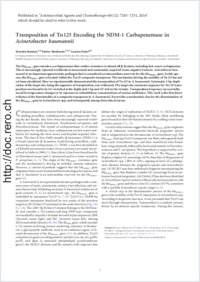Transposition of tn125 encoding the ndm-1 carbapenemase in Acinetobacter baumannii
- Bontron, Séverine Emerging Antibiotic Resistance Unit, Medical and Molecular Microbiology, Department of Medicine, Faculty of Science, University of Fribourg, Switzerland - INSERM European Unit (LEA Paris, France), University of Fribourg, Switzerland
- Nordmann, Patrice Emerging Antibiotic Resistance Unit, Medical and Molecular Microbiology, Department of Medicine, Faculty of Science, University of Fribourg, Switzerland - INSERM European Unit (LEA Paris, France), University of Fribourg, Switzerland - University of Lausanne and University Hospital Center, Lausanne, Switzerland
- Poirel, Laurent Emerging Antibiotic Resistance Unit, Medical and Molecular Microbiology, Department of Medicine, Faculty of Science, University of Fribourg, Switzerland - INSERM European Unit (LEA Paris, France), University of Fribourg, Switzerland
-
12.01.2016
Published in:
- Antimicrobial Agents and Chemotherapy. - 2016, vol. 60, no. 12, p. 7245–7251
English
The blaNDM-1 gene encodes a carbapenemase that confers resistance to almost all β-lactams, including last-resort carbapenems. This is increasingly reported worldwide in nosocomial and community-acquired Gram-negative bacteria. Acinetobacter baumannii is an important opportunistic pathogen that is considered an intermediate reservoir for the blaNDM-1 gene. In this species, the blaNDM-1 gene is located within the Tn125 composite transposon. The mechanism driving the mobility of Tn125 has not yet been elucidated. Here we experimentally demonstrated the transposition of Tn125 in A. baumannii. Systematic 3-bp duplication of the target site, being the signature of transposition, was evidenced. The target site consensus sequence for Tn125 transposition was found to be GC enriched at the duplicated 3 bp and AT rich in the vicinity. Transposition frequency was not influenced by temperature changes or by exposure to subinhibitory concentrations of various antibiotics. This work is the first direct evidence of the functionality of a composite transposon in A. baumannii. It provides a mechanistic clue for the dissemination of the blaNDM-1 gene in Acinetobacter spp. and subsequently among Enterobacteriaceae.
- Faculty
- Faculté des sciences et de médecine
- Department
- Médecine 3ème année
- Language
-
- English
- Classification
- Biological sciences
- License
-
License undefined
- Identifiers
-
- RERO DOC 278669
- DOI 10.1128/AAC.01755-16
- Persistent URL
- https://folia.unifr.ch/unifr/documents/305378
Statistics
Document views: 128
File downloads:
- pdf: 205
